The Wireless Home Security Camera Market is estimated to be valued at USD 11.1 billion in 2025 and is projected to reach USD 39.8 billion by 2035, registering a compound annual growth rate (CAGR) of 13.6% over the forecast period. This strong growth is supported, driven by increasing demand for home security solutions, advancements in wireless technologies, and the growing adoption of smart home ecosystems. In the first five-year phase (2025–2030), the market is expected to expand from USD 11.1 billion to USD 22.6 billion, adding USD 11.5 billion, which accounts for 40% of the total incremental growth.
The second phase (2030–2035) will contribute USD 17.2 billion, representing 60% of incremental growth, reflecting stronger momentum as the market matures and demand for high-definition, AI-powered, and integrated security solutions increases. Annual increments will rise from USD 2 billion in early years to USD 4 billion by 2035, as innovations in video analytics, cloud storage, and mobile connectivity boost market adoption. Manufacturers focusing on affordable, high-performance cameras with enhanced features will capture the largest share of this USD 28.7 billion opportunity.
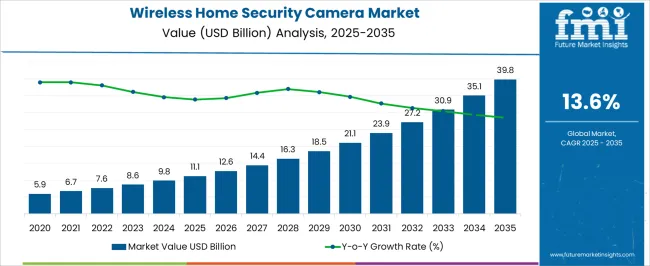
| Metric | Value |
|---|---|
| Wireless Home Security Camera Market Estimated Value in (2025 E) | USD 11.1 billion |
| Wireless Home Security Camera Market Forecast Value in (2035 F) | USD 39.8 billion |
| Forecast CAGR (2025 to 2035) | 13.6% |
The Wireless Home Security Camera market is experiencing consistent growth, supported by rising consumer demand for smart surveillance systems, increasing concerns around residential safety, and the expanding availability of high-speed internet. Advancements in camera technology, particularly in resolution and connectivity, are enabling more effective monitoring solutions, which are being widely adopted across urban and suburban households.
Industry announcements and corporate communications have highlighted the integration of AI and cloud-based storage in these systems, enhancing their capabilities for real-time alerts and remote access. Growth is also being influenced by the proliferation of smart home ecosystems, which allow seamless integration of wireless cameras with other connected devices.
Ongoing product innovation, affordability of devices, and rising awareness of home automation are expected to drive future adoption. Additionally, improved data encryption and compliance with privacy regulations are making wireless security solutions more acceptable to consumers, creating a pathway for continued market expansion in developed and emerging economies.
The wireless home security camera market is segmented by resolution, type, application, distribution channel, and geographic regions. By resolution, the wireless home security camera market is divided into HD (720p & 1080p), 2K, and 4K. In terms of the type of wireless home security camera, the market is classified into IP cameras and PTZ cameras. The wireless home security camera market is segmented into outdoor cameras, doorbell cameras, and indoor cameras. The distribution channel of the wireless home security camera market is segmented into Online and Offline. Regionally, the wireless home security camera industry is classified into North America, Latin America, Western Europe, Eastern Europe, Balkan & Baltic Countries, Russia & Belarus, Central Asia, East Asia, South Asia & Pacific, and the Middle East & Africa.
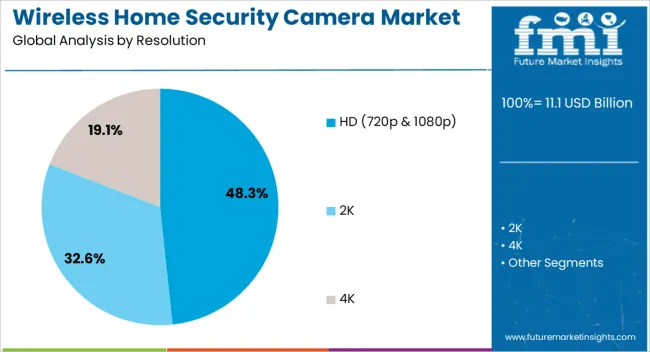
The HD resolution segment, comprising 720p and 1080p cameras, is projected to hold 48.3% of the Wireless Home Security Camera market revenue share in 2025. This leading share has been driven by the balance these resolutions offer between video quality, data storage efficiency, and device affordability.
HD cameras have been widely adopted due to their capability to provide clear, detailed footage suitable for general home surveillance without requiring high bandwidth or advanced infrastructure. Corporate press announcements and product feature updates have indicated that most consumers prefer HD for its compatibility with mobile apps and cloud platforms, making remote access and playback convenient.
Additionally, industry communications have emphasized that HD resolutions are often bundled with entry-level and mid-range models, making them accessible to a larger segment of homeowners The cost-effectiveness, energy efficiency, and ability to integrate with smart home systems have also contributed to the segment’s sustained dominance in the residential security market.
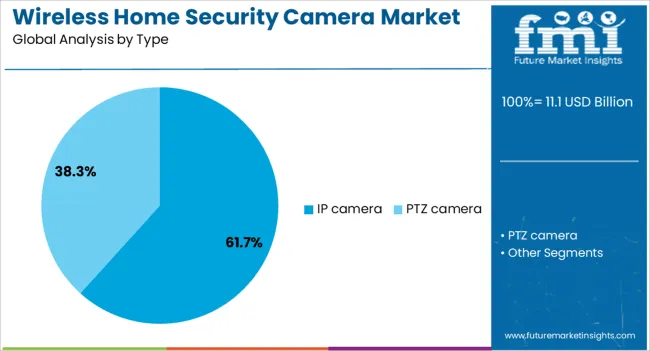
The IP camera segment is expected to command 61.7% of the Wireless Home Security Camera market revenue share in 2025, marking it as the leading type segment. The growing preference for IP cameras has been influenced by their capability to offer real-time video streaming, advanced encryption, and compatibility with cloud-based storage systems.
IP cameras have been increasingly favored for their superior image quality, remote monitoring features, and seamless integration with smart home platforms, as noted in technology manufacturer briefings and smart home product launches. These cameras support software updates and advanced motion detection, which improve threat recognition and alerting mechanisms.
The segment’s growth has also been reinforced by declining hardware costs and greater public awareness around the benefits of network-connected devices Furthermore, the convenience of installation and scalability of IP camera systems have made them a preferred choice for modern home surveillance, leading to their continued market leadership.

The outdoor camera segment is forecasted to account for 43.5% of the Wireless Home Security Camera market revenue share in 2025, positioning it as the leading application segment. This growth has been supported by heightened consumer emphasis on perimeter security and the need for continuous monitoring of exterior spaces such as entrances, driveways, and gardens.
According to corporate statements and product launches, outdoor cameras are now being equipped with features such as weather resistance, night vision, motion detection, and floodlight integration, making them highly effective for deterrence and surveillance. Industry experts have emphasized the role of rising urban crime rates and the expansion of smart residential communities in driving outdoor camera installations.
Furthermore, the ability of outdoor models to connect wirelessly to mobile devices and provide real-time alerts has made them increasingly appealing to homeowners These factors, combined with advancements in camera durability and AI-enabled monitoring, have driven the outdoor segment’s dominant position in the overall market.
The wireless home security camera market is driven by rising demand for reliable, easy-to-install home security solutions. Opportunities in the growing smart home and DIY sectors are fueling growth, while trends in AI integration and cloud services are reshaping the market. However, challenges related to privacy concerns and high data costs may limit adoption. By 2025, overcoming these challenges through improved data security and cost-effective storage solutions will be key to sustaining market growth.
The wireless home security camera market is growing due to the increasing demand for advanced home security and surveillance systems. As concerns about burglary, property damage, and safety rise, consumers are seeking reliable, easy-to-install security solutions. Wireless cameras offer convenience, flexibility, and integration with mobile devices, allowing homeowners to monitor their properties remotely. By 2025, this growing demand for home security solutions will continue to drive market growth, particularly in regions with expanding middle-class populations.
Opportunities in the wireless home security camera market are growing with the rise of smart homes and the DIY market. Consumers are increasingly interested in affordable, easy-to-install systems that can integrate with other smart devices like doorbell cameras, motion sensors, and smart locks. The DIY trend, along with the demand for smart home solutions, is expected to fuel market expansion. By 2025, continued adoption of home automation and DIY security installations will provide significant growth opportunities for wireless camera manufacturers.
Emerging trends in the wireless home security camera market include the integration of AI and cloud-based services. AI-powered cameras can offer features like facial recognition, motion tracking, and automatic alerts, enhancing security and user experience. Additionally, cloud storage solutions provide homeowners with easy access to recorded footage from anywhere, improving data security and retrieval. By 2025, AI integration and cloud services will become a significant trend in the market, as consumers seek smarter, more efficient security systems.
Despite growth, challenges related to privacy concerns and high data storage costs persist in the wireless home security camera market. As more consumers use cloud-based services to store footage, concerns about data security and unauthorized access increase. Additionally, the ongoing costs associated with cloud storage subscriptions can deter some customers from fully adopting these systems. By 2025, addressing these issues through improved security protocols and more affordable data storage solutions will be critical for expanding the market.
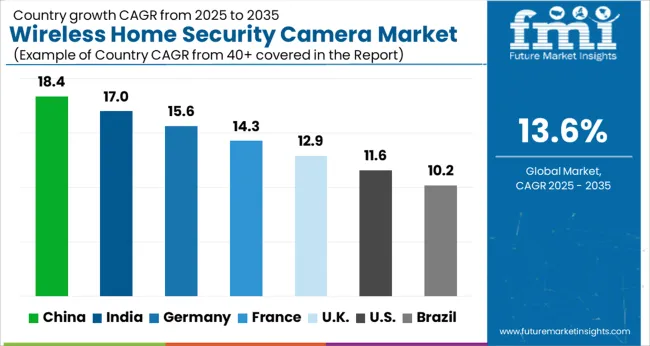
The global wireless home security camera market is projected to grow at a 13.6% CAGR from 2025 to 2035. China leads with a growth rate of 18.4%, followed by India at 17.0%, and Germany at 15.6%. The United Kingdom records a growth rate of 12.9%, while the United States shows the slowest growth at 11.6%. These varying growth rates are driven by factors such as increasing consumer demand for home security solutions, technological advancements in wireless communication, and the growing adoption of smart homes. Emerging markets like China and India are experiencing higher growth due to urbanization, rising disposable incomes, and increasing awareness of home security, while more mature markets like the USA and the UK see steady growth driven by advancements in smart home integration and regulatory standards for security devices. This report includes insights on 40+ countries; the top markets are shown here for reference.
The wireless home security camera market in India is projected to grow at a CAGR of 17.0%. India’s increasing urban population, growing middle class, and rising awareness of home security are driving demand for wireless home security solutions. The country’s focus on adopting smart home technologies and the expanding availability of affordable wireless security cameras are contributing to the market’s growth. Additionally, India’s growing e-commerce sector, which offers easy access to home security products, along with the increasing desire for personal safety and property protection, is further fueling market adoption.
The high pressure processing machines market in India is projected to grow at a CAGR of 5.6%. India’s expanding food processing sector, along with increasing consumer awareness regarding food quality and safety, is driving the demand for HPP machines. The growing popularity of fresh, natural, and preservative-free foods in the country’s urban areas is further contributing to the market’s growth. Additionally, India’s focus on enhancing food safety and processing technologies, particularly in the dairy, fruits, and vegetable sectors, is accelerating the adoption of HPP solutions.
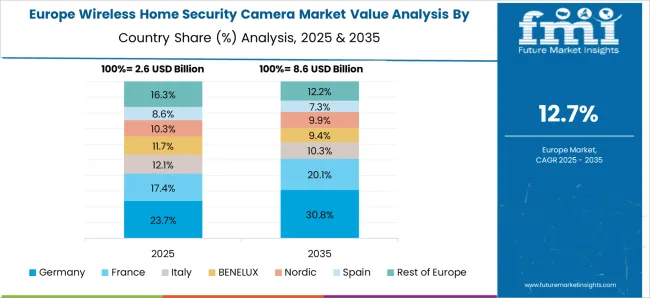
The wireless home security camera market in Germany is projected to grow at a CAGR of 15.6%. Germany’s well-established demand for smart home technologies, coupled with increasing concerns over property security, is driving steady market growth. The country’s growing adoption of IoT-based home security solutions and the increasing preference for wireless security cameras that offer easy installation and remote monitoring are contributing to the market’s expansion. Additionally, Germany’s regulatory environment, which places emphasis on privacy and data security, supports the demand for secure and reliable wireless home security systems.
The wireless home security camera market in the United Kingdom is projected to grow at a CAGR of 12.9%. The UK market is driven by increasing consumer demand for smart home solutions, particularly in the context of home security. The adoption of wireless security cameras, which offer ease of installation and remote monitoring via smartphones, is gaining momentum. Additionally, the growing trend of home automation, coupled with concerns over burglary and theft, is contributing to steady market growth. The UK’s regulatory framework promoting data protection and privacy further boosts demand for secure wireless home security systems.
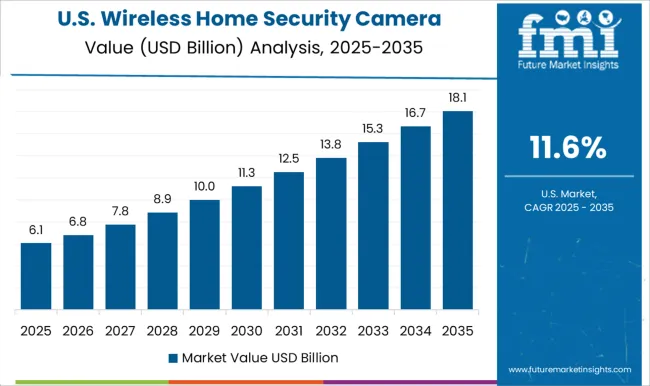
The wireless home security camera market in the United States is expected to grow at a CAGR of 11.6%. The USA market remains strong, driven by the growing demand for home automation and security systems. The increasing preference for wireless security cameras, which offer flexibility, ease of use, and integration with smart home ecosystems, is contributing to steady market growth. The USA market is also influenced by the rising concerns about property theft, personal safety, and privacy, along with advancements in cloud storage and video surveillance technology.
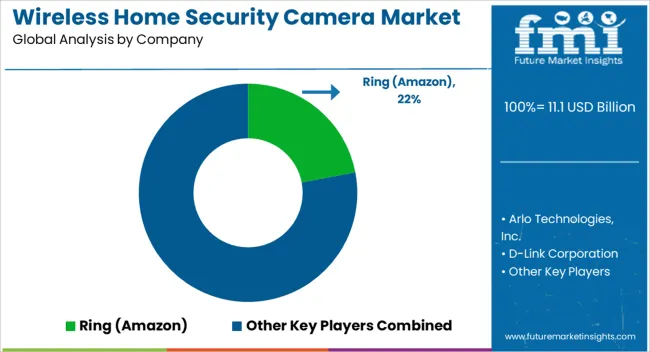
The wireless home security camera market is dominated by Ring (Amazon), which leads with its smart, user-friendly cameras that offer high-quality video surveillance, motion detection, and integration with smart home ecosystems. Ring’s dominance is supported by its strong brand recognition, innovative features, and seamless integration with Amazon’s Alexa, making it a preferred choice for home security. Key players such as Arlo Technologies, Inc., Google LLC, and SimpliSafe, Inc. maintain significant market shares by offering advanced, cloud-based security systems designed to provide real-time video streaming, two-way audio, and automated alerts.
These companies focus on enhancing camera resolution, improving battery life, and ensuring ease of installation for consumers. Emerging players like D-Link Corporation, Xiaomi Corporation, and Vivint, Inc. are expanding their market presence by offering affordable, high-performance wireless security cameras that cater to different market segments, from budget-conscious consumers to premium users. Their strategies include improving product design, offering enhanced features like night vision and motion sensing, and focusing on user-friendly apps for remote monitoring. Market growth is driven by the increasing demand for smart home security solutions, rising concerns about home safety, and the proliferation of IoT devices. Innovations in artificial intelligence, facial recognition, and integration with other smart home devices are expected to continue shaping competitive dynamics and drive further growth in the global wireless home security camera market.
| Item | Value |
|---|---|
| Quantitative Units | USD 11.1 Billion |
| Resolution | HD (720p & 1080p), 2K, and 4K |
| Type | IP camera and PTZ camera |
| Application | Outdoor camera, Doorbell camera, and Indoor camera |
| Distribution Channel | Online and Offline |
| Regions Covered | North America, Europe, Asia-Pacific, Latin America, Middle East & Africa |
| Country Covered | United States, Canada, Germany, France, United Kingdom, China, Japan, India, Brazil, South Africa |
| Key Companies Profiled | Ring (Amazon), Arlo Technologies, Inc., D-Link Corporation, Google LLC, SimpliSafe, Inc, Xiaomi Corporation, and Vivint, Inc |
| Additional Attributes | Dollar sales by camera type and application, demand dynamics across residential, commercial, and surveillance sectors, regional trends in wireless home security camera adoption, innovation in AI-driven features and cloud storage, impact of regulatory standards on data privacy and safety, and emerging use cases in smart home integration and remote monitoring systems. |
The global wireless home security camera market is estimated to be valued at USD 11.1 billion in 2025.
The market size for the wireless home security camera market is projected to reach USD 39.8 billion by 2035.
The wireless home security camera market is expected to grow at a 13.6% CAGR between 2025 and 2035.
The key product types in wireless home security camera market are hd (720p & 1080p), 2k and 4k.
In terms of type, ip camera segment to command 61.7% share in the wireless home security camera market in 2025.






Full Research Suite comprises of:
Market outlook & trends analysis
Interviews & case studies
Strategic recommendations
Vendor profiles & capabilities analysis
5-year forecasts
8 regions and 60+ country-level data splits
Market segment data splits
12 months of continuous data updates
DELIVERED AS:
PDF EXCEL ONLINE
Wireless Access Point Market Size and Share Forecast Outlook 2025 to 2035
Wireless Video - 2.4/5GHz Market Size and Share Forecast Outlook 2025 to 2035
Wireless Polysomnography Market Size and Share Forecast Outlook 2025 to 2035
Wireless Audio Devices Market Size and Share Forecast Outlook 2025 to 2035
Wireless Communication Technologies In Healthcare Market Size and Share Forecast Outlook 2025 to 2035
Wireless Mesh Network Market Size and Share Forecast Outlook 2025 to 2035
Wireless Sensor Tags Market Size and Share Forecast Outlook 2025 to 2035
Wireless Sensor Network Market Size and Share Forecast Outlook 2025 to 2035
Wireless Power Transmission Market Size and Share Forecast Outlook 2025 to 2035
Wireless Testing Market Size and Share Forecast Outlook 2025 to 2035
Wireless Power Bank Market Size and Share Forecast Outlook 2025 to 2035
Wireless Battery Monitoring System Market Size and Share Forecast Outlook 2025 to 2035
Wireless Printer Market Size and Share Forecast Outlook 2025 to 2035
Wireless Headphones Market Size and Share Forecast Outlook 2025 to 2035
Wireless Sensors Market Size and Share Forecast Outlook 2025 to 2035
Wireless Display Market Size and Share Forecast Outlook 2025 to 2035
Wireless Paging Systems Market Size and Share Forecast Outlook 2025 to 2035
Wireless Patient Monitoring Market Size and Share Forecast Outlook 2025 to 2035
Wireless Earphone Market Size and Share Forecast Outlook 2025 to 2035
Wireless Ev Charging Market Size and Share Forecast Outlook 2025 to 2035

Thank you!
You will receive an email from our Business Development Manager. Please be sure to check your SPAM/JUNK folder too.
Chat With
MaRIA